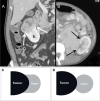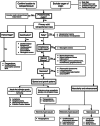Solid Primary Retroperitoneal Masses in Adults: An Imaging Approach
- PMID: 35924125
- PMCID: PMC9340194
- DOI: 10.1055/s-0042-1744142
Solid Primary Retroperitoneal Masses in Adults: An Imaging Approach
Abstract
Mass lesions in the retroperitoneal space may be primary or secondary. Primary retroperitoneal mass lesions are relatively uncommon as compared to pathology that arises secondarily from retroperitoneal organs. These may be solid or cystic lesions. The overlapping imaging features of various solid primary retroperitoneal tumors make the diagnosis difficult, and hence, histopathology remains the mainstay of diagnosis. This paper provides a brief review of the anatomy of the retroperitoneal space and provides an algorithmic approach based on cross-sectional imaging techniques to narrow down the differential diagnosis of solid primary retroperitoneal masses encountered in the adult population.
Keywords: Algorithmic approach; Anatomy; Imaging; Retroperitoneal space; Solid.
Indian Radiological Association. This is an open access article published by Thieme under the terms of the Creative Commons Attribution-NonDerivative-NonCommercial License, permitting copying and reproduction so long as the original work is given appropriate credit. Contents may not be used for commercial purposes, or adapted, remixed, transformed or built upon. ( https://creativecommons.org/licenses/by-nc-nd/4.0/ ).
Conflict of interest statement
Conflicts of Interest None declared.
Figures


















Similar articles
-
Primary retroperitoneal masses: what is the differential diagnosis?Abdom Imaging. 2015 Aug;40(6):1887-903. doi: 10.1007/s00261-014-0311-x. Abdom Imaging. 2015. PMID: 25468494 Review.
-
Practical approach to primary retroperitoneal masses in adults.Radiol Bras. 2018 Nov-Dec;51(6):391-400. doi: 10.1590/0100-3984.2017.0179. Radiol Bras. 2018. PMID: 30559557 Free PMC article.
-
Imaging of uncommon retroperitoneal masses.Radiographics. 2011 Jul-Aug;31(4):949-76. doi: 10.1148/rg.314095132. Radiographics. 2011. PMID: 21768233
-
The gamut of primary retroperitoneal masses: multimodality evaluation with pathologic correlation.Abdom Radiol (NY). 2016 Jul;41(7):1411-30. doi: 10.1007/s00261-016-0735-6. Abdom Radiol (NY). 2016. PMID: 27271217 Review.
-
A comprehensive review of the retroperitoneal anatomy, neoplasms, and pattern of disease spread.Curr Probl Diagn Radiol. 2013 Sep-Oct;42(5):191-208. doi: 10.1067/j.cpradiol.2013.02.001. Curr Probl Diagn Radiol. 2013. PMID: 24070713 Review.
Cited by
-
Salmonella bovismorbificans abscess masking a primary testicular tumour in the retroperitoneum - A case report.Int J Surg Case Rep. 2024 Dec;125:110502. doi: 10.1016/j.ijscr.2024.110502. Epub 2024 Oct 23. Int J Surg Case Rep. 2024. PMID: 39461139 Free PMC article.
-
ARID1A-Deficient and 11q13-Amplified Metastatic Pancreatic Cancer Initially Presenting as Retroperitoneal Fibrosis in a Patient with Familial CHEK2 Variant.Diagnostics (Basel). 2025 Aug 9;15(16):1998. doi: 10.3390/diagnostics15161998. Diagnostics (Basel). 2025. PMID: 40870849 Free PMC article.
-
Diagnostic and surgical management of giant broad ligament myoma with cystic degeneration: A case report.World J Clin Cases. 2025 Sep 26;13(27):108923. doi: 10.12998/wjcc.v13.i27.108923. World J Clin Cases. 2025. PMID: 40881898
-
Comprehensive neurosurgical and visceral surgical therapy of retroperitoneal nerve tumors: a descriptive and retrospective analysis.World J Surg Oncol. 2024 Oct 22;22(1):277. doi: 10.1186/s12957-024-03557-5. World J Surg Oncol. 2024. PMID: 39434082 Free PMC article.
-
Safety and efficacy of laparoscopic transperitoneal versus retroperitoneal resection for benign retroperitoneal tumors: a retrospective cohort study.Surg Endosc. 2023 Dec;37(12):9299-9309. doi: 10.1007/s00464-023-10504-0. Epub 2023 Oct 26. Surg Endosc. 2023. PMID: 37884734
References
-
- Rajiah P, Sinha R, Cuevas C, Dubinsky T J, Bush W H, Jr, Kolokythas O. Imaging of uncommon retroperitoneal masses. Radiographics. 2011;31(04):949–976. - PubMed
-
- Osman S, Lehnert B E, Elojeimy S et al.A comprehensive review of the retroperitoneal anatomy, neoplasms, and pattern of disease spread. Curr Probl Diagn Radiol. 2013;42(05):191–208. - PubMed
-
- Goenka A H, Shah S N, Remer E M.Imaging of the retroperitoneum Radiol Clin North Am 20125002333–355., vii - PubMed
LinkOut - more resources
Full Text Sources

